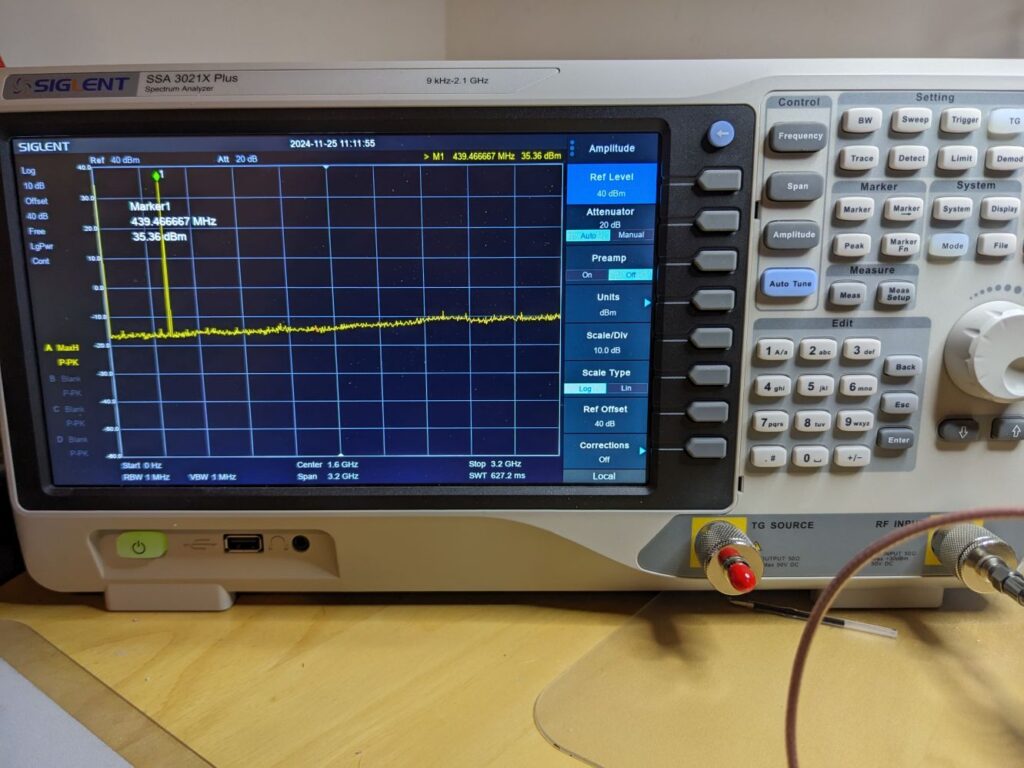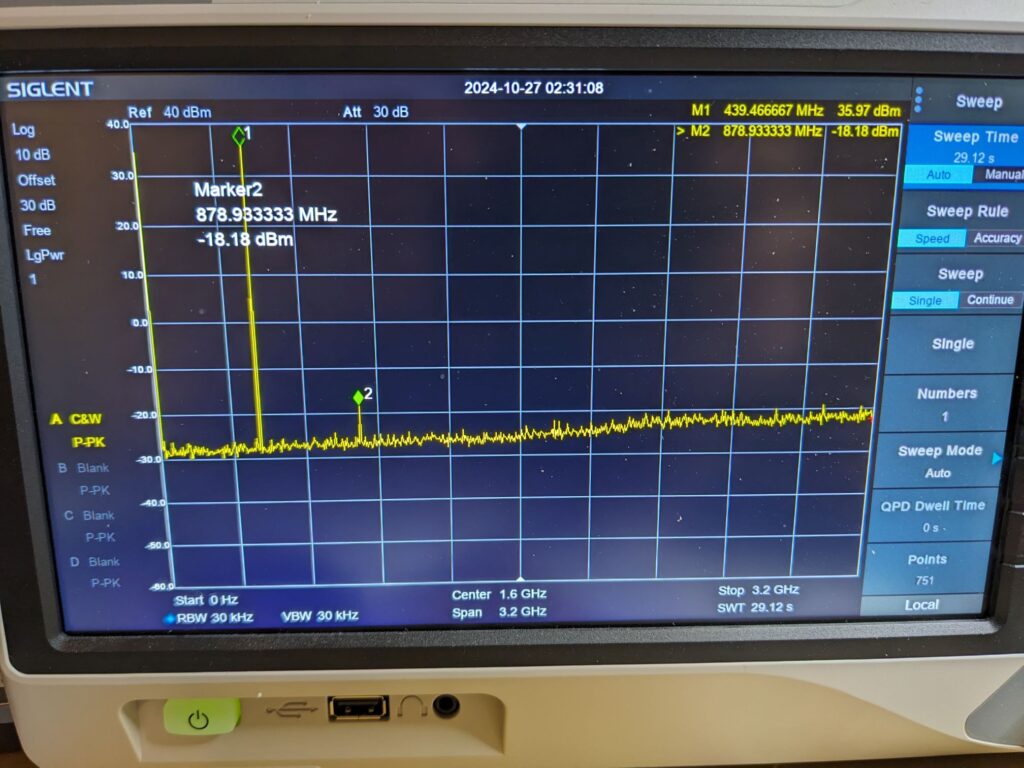
Baofeng is a Chinese radio manufacturer that produces a line of radio transceivers. Starting with their UV-5 series, they became insanely popular because they are dramatically less expensive than competing products. A good HT from Yaesu, Icom, Kenwood, or Alinco costs over $100 and usually a few hundred dollars, but a Baofeng HT can be purchased for less than $20; a price point that was unheard of previously and simply amazing.
I couldn’t resist so I bought a few several years ago. I played with them briefly, confirmed that I could hit my local repeaters in the 70cm band, and then they sat on the shelf. Recently, I became interested in amateur radio again and decided to take a closer look at the performance of the radio. Does it reach its specified transmit power? What’s the receiver sensitivity? Most importantly, part of the responsibility of being a ham licensee is making sure you transmit in compliance with FCC regulations (FCC CFR 47 part 97) is it compliant? If it causes you to lose your license, it was no bargain.
TLDR: it turns out that most Baofeng radios are not compliant with FCC rules for amateur radio. To be compliant (47CFR Part 97.307e), any signals other than the intended (fundamental) transmit frequency must be at least -40dBc AND below -16dBm. Of the 5 Baofeng radio models I tested, only one was compliant. The rest generated unwanted (spurious) signals on multiples (harmonics) of the fundamental that violate the rules. Nevertheless, the GT-5R appears to be fully FCC compliant and an incredibly value. Details of all the radios I tested are below:
GT-5R (not Pro) – PASS!
After evaluating 4 Baofeng models that were not legal to transmit with on the amateur bands, I was delighted that the 5th time was the charm! The spectrum analyzer tells the tale (see pics below). For $18.39 with free shipping through amazon, the Baofeng GT-5R is indeed a dual-band 4W+ radio with proper harmonic suppression that allows licensed amateur radio operators to legally transmit in the 2m and 70cm bands. It’s absolutely insane that they can hit this price point; kudos to Baofeng!


Transmit power (on high) was +35.54dBm (3.58W) on 2m and +36.55dBm (4.5W) on 70cm.
The measurements do not include cable or connector loss, but that should be very low at these frequencies with 12″ of RG-316. I confirmed the 10dB and 30dB attenuators were spot on using a calibrated RF signal generator. My total amplitude measurement error should have been (a lot) less than 1dB.
I also stepped through each harmonic with the analyzer zoomed in (50kHz span, 300Hz RBW, noise floor below -50dBm) and saw nothing of interest; the only measurable harmonic when transmitting on 2m was the 2nd which was below -30dBm. I was so pleased that I bought a second GT-5R which was also clean when checked (and had higher output power).
UV-17 Pro GPS – FAIL
Would 4th time be a charm? Nope. I ordered a pair of Baofeng UV-17 Pro GPS based on several internet reviews that suggested *they* would be clean and legal to transmit with. Although it’s a neat tri-band HT, sadly, the story was the same as with the other models I tested previously (below): not legal to transmit with on 2m or 1.25m, OK on 70cm. They’re going back tomorrow. The spectrum analyzer (with 40dB of attenuation in front), shows the 2nd harmonic on 2m is at +19dBm!:



UV-82 – FAIL
I connected my Baofeng UV-82, a dual-band (2m, 70cm) HT rated for 1W low and 5W high output power to a spectrum analyzer through a 30dB attenuator and transmitted on 2m and 70cm; the results and discussion are below:

The transmitted power on 2m at the intended frequency was 3.9W which is pretty good, but the harmonics are awful. FCC regulations (47CFR Part 97.307e) state that spurious transmissions must be at least -40dBc (40dB below the carrier level) AND less than 25uW (-16dBm). The UV82 doesn’t even come close. The second harmonic is only -19.45dBc and even the third harmonic isn’t down 40dB. Both are well above -16dBm.
I switched the radio to 70cm and again transmitted at full power:

These results at 70cm are much better: the fundamental is at 4W and the second harmonic is down more than 40dB and is below -16dBm. The third harmonic isn’t visible. So, while there isn’t much margin, the UV82 appears to be good for amateur use at 70cm, but is not compliant in the 2m band.
It seems likely that the UV82 contains a low-pass filter that attenuates signals above 450MHz; which makes the radio compliant in the 70cm band, but is worthless for use in the 2m band due to the 2nd and 3rd harmonics. To use the radio in the 2m band legally, you probably need to install a 200MHz low-pass filter such as Mini-Circuits VLFX-225+ between the radio and antenna.
UV-B5 – FAIL
I also have a pair of Baofeng UV-B5 transceivers. They are also problematic with respect to spurious emissions, but interestingly in different ways from the UV82.


In both bands, only the second harmonic is present with good suppression of higher harmonics. Unfortunately, the second harmonic violates the FCC regulations in all cases, so the UV-B5 can’t be used to transmit legally in either band. Compliance requires spurious to be BOTH -40dBc or better AND -16dBm or lower. I tested at high and low power and the second harmonic was much too high. Note: low power was measured at 1.5W at 2m and 1.25W at 70cm.
- 2m High Power: second harmonic is -40dBc (good!), but is -4.82dBm (fails compliance)
- 2m Low Power: second harmonic is at -5.88dBm (fails compliance)
- 70cm High Power: second harmonic is -34.25dBc and at -0.12dBm. (fails compliance)
- 70cm Low Power: second harmonic is at -8.08dBm (fails compliance)
This behavior is different from the UV-82; the third harmonic and above are well suppressed in both bands so these radios likely have separate VHF and UHF PAs (or at least harmonic filters). Unfortunately, they do not seem to be adequate and, as far as I can tell, it is likely illegal to transmit with the UV-B5 in either band, even at low power, unless you add additional filtering between the transceiver and the antenna.
The UV-B5s have another serious design flaw: if you leave the battery connected, it will gradually be drained, even with the radio off; so you must store the UV-B5 with the battery disconnected. Note: this is not the case for the UV-82.
GT-5R PRO – FAIL
I contacted Baofeng and they advised that their UV-5R and GT-5R comply with FCC part 97 & 15B. On their website, the GT-5R PRO is also advertised as FCC compliant and is tri-band, so I ordered a pair of GT-5R PRO and was dismayed to see that they too appear to be non-compliant on 2m. The first unit transmits at 3.37W at high power and has a huge spur at the second harmonic.

The second unit also transmitted at 3.3W at high power in the 2m band (35dBm) with a somewhat lower spur at the second harmonic of 0 dBm: better, but still not -40dBc AND below -16dBm. Interestingly, when transmitting at low power, the fundamental drops to 1.5W, but the 2nd harmonic actually goes UP by about 4dB!
The GT-5R PRO appears to be compliant in the 70cm band with the fundamental at 4.35W and no spurs above -20dBm.

It’s possible I’m doing something wrong in my measurements; I would have liked to filter out the fundamental with a notch or high-pass filter before measuring the harmonics, but I don’t have the right filter and with the signal already knocked down 30-40dB, I don’t think I’m over-driving the SA. So I returned the GT-5R PROs.
